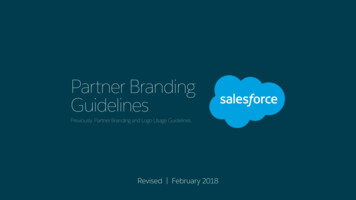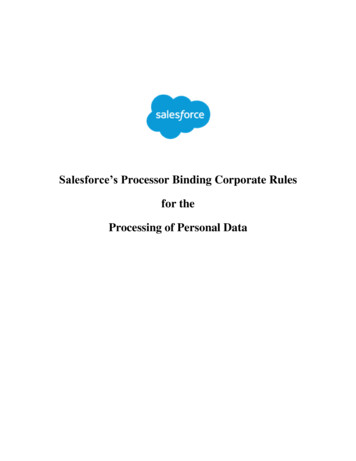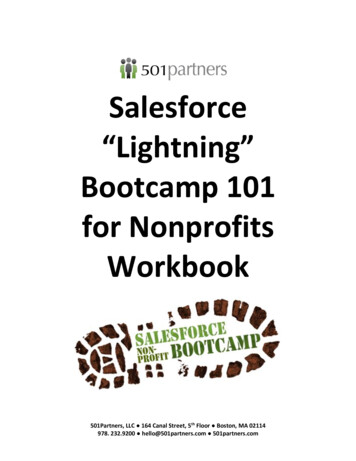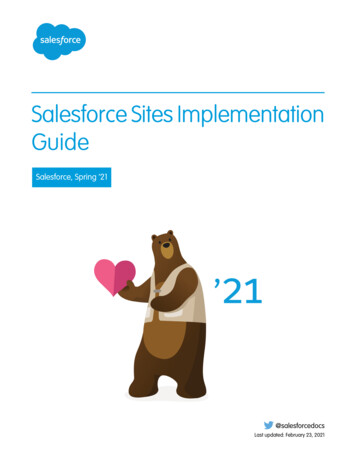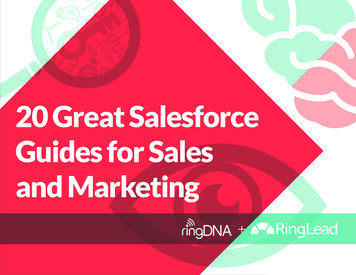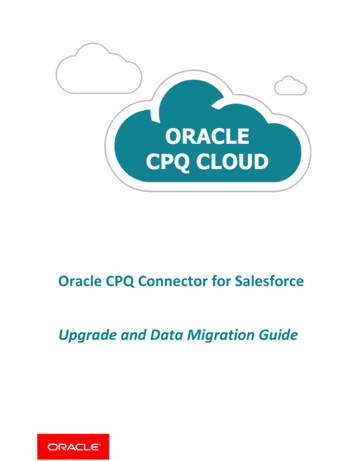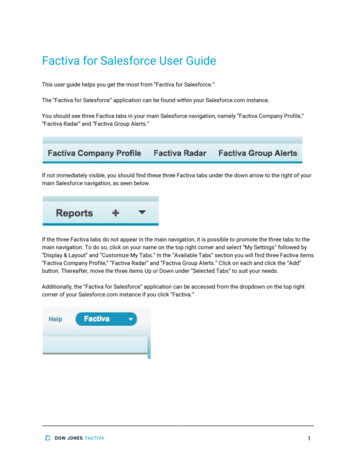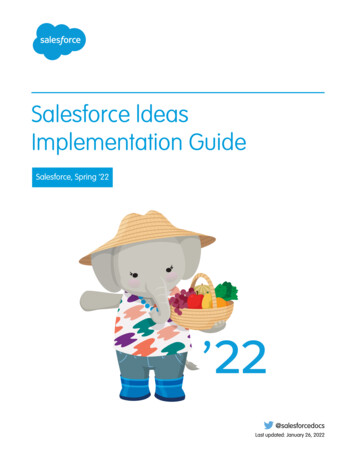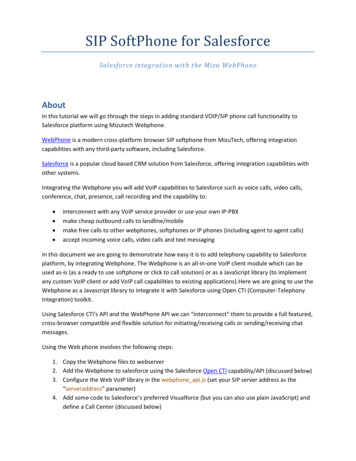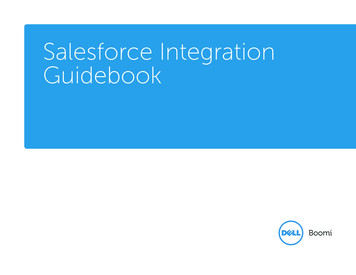
Transcription
Salesforce#salesforce
Table of ContentsAbout1Chapter 1: Getting started with Salesforce2Remarks2Examples2Installation or Setup2Salesforce Products2Sales Cloud2Service Cloud2Marketing Cloud2Community Cloud2Analytics Cloud aka Wave Analytics2App Cloud3IoT Cloud3Industry Specific Products3Financial Services Cloud3Health Cloud3Heroku3Chapter 2: Apex TestingExamples44Assert Methods4Basic Test Class4Using testSetup5Using static blocks5Assertion Methods6Chapter 3: Apex Triggers7Syntax7Parameters7Examples7Basic trigger7Trigger context variables7
Manipulating records that fired the triggerChapter 4: Approval Process ocessNode12ProcessInstance12ProcessInstanceStep & Chapter 5: Custom Settings14Remarks14Introduction14List Custom Settings14Examples15Creating & Managing Custom Settings15Creation15Management15Using Hierarchy Custom Settings To Disable Workflow / Validation Rules16Custom Setting16Custom Setting Field17Custom Setting Field Value17Validation Rule18Workflow Rules19Using Hierarchy Custom Settings To Disable Apex Code19Explanation19Apex Class19Unit Test19Updating Hierarchy Custom Settings in Apex CodeChapter 6: Date Time ManipulationExamplesEasily Find Last Day of a Month21262626
Chapter 7: Global Variables in classes27Introduction27Examples27UserInfo27Chapter 8: Global Variables on Visualforce pagesExamples2828 Resource28 Label28 User28Chapter 9: Page Navigation with help of list wrapper class in sales force.29Introduction29Examples29Pagination ControllerChapter 10: SalesForce CI Integration2933Introduction33Examples33How to configure Jenkins to deploy code on Development or Production org ?33Jenkins CI tools which can be used for SalesForce Automation33Chapter 11: Salesforce Object Query Language (SOQL)34Syntax34Examples34Basic SOQL Query34SOQL Query With Filtering34SOQL Query With Ordering35Using SOQL to Construct a Map35SOQL Query to Reference Parent Object's Fields35SOQL Queries in Apex36Variable References in Apex SOQL Queries36Potential Exceptions in Apex SOQL Queries36Using a Semi-Join37Dynamic SOQL37Chapter 12: Salesforce REST API38
Introduction38Examples38OAuth2 access token and list of servicesChapter 13: Tools for DevelopmentExamples383939IDEs39Browser extensions39Debuggers39Salesforce ETL tools40Static Analysis Tools40Chapter 14: Trigger BulkificationExamplesBulkificationChapter 15: Visualforce Page DevelopmentExamples4141414242Basic page42Using Standard Controllers42Chapter 16: Working with External SystemsExamplesMaking an outbound calloutCredits43434344
AboutYou can share this PDF with anyone you feel could benefit from it, downloaded the latest versionfrom: salesforceIt is an unofficial and free Salesforce ebook created for educational purposes. All the content isextracted from Stack Overflow Documentation, which is written by many hardworking individuals atStack Overflow. It is neither affiliated with Stack Overflow nor official Salesforce.The content is released under Creative Commons BY-SA, and the list of contributors to eachchapter are provided in the credits section at the end of this book. Images may be copyright oftheir respective owners unless otherwise specified. All trademarks and registered trademarks arethe property of their respective company owners.Use the content presented in this book at your own risk; it is not guaranteed to be correct noraccurate, please send your feedback and corrections to info@zzzprojects.comhttps://riptutorial.com/1
Chapter 1: Getting started with SalesforceRemarksThis section provides an overview of what salesforce is, and why a developer might want to use it.It should also mention any large subjects within salesforce, and link out to the related topics. Sincethe Documentation for salesforce is new, you may need to create initial versions of those relatedtopics.ExamplesInstallation or SetupThe best way to get started with Salesforce is to get your own Developer Edition.Developer Edition (often referred to as a "DE org") is a fully-featured development environmentwith limits on data and users. Developer Edition is where you can get familiar with theenvironment, try out stuff and mess around in Salesforce.com. Developer edition is anenvironment lets you instantly start developing, testing and deploying your app in the cloud.Salesforce ProductsThe Salesforce application consists of several products which can be integrated with each other:Sales CloudMarketing Page, Salesforce DocumentationService CloudMarketing Page, Salesforce Documentation, TrailheadMarketing CloudMarketing PageCommunity CloudMarketing Page, Salesforce DocumentationAnalytics Cloud aka Wave Analyticshttps://riptutorial.com/2
Marketing Page, Salesforce Documentation, TrailheadApp CloudMarketing PageIoT CloudMarketing PageIndustry Specific ProductsFinancial Services CloudMarketing Page, Salesforce DocumentationHealth CloudMarketing Page, Salesforce DocumentationHerokuMarketing PageRead Getting started with Salesforce online: 3
Chapter 2: Apex TestingExamplesAssert Methodsstatic TestMethod void DmlTest() {List Contact allContacts [SELECT Id FROM act testContact new Contact(FirstName 'John', LastName 'Doe');insert testContact;allContacts [SELECT Id FROM Contact];System.assertNotEquals(0, allContacts.size(), 'Optional message in case of failure');delete allContacts;allContacts [SELECT Id FROM Contact];System.assertEquals(0, allContacts.size());}Basic Test ClassThis test class will test the IsBlank(.) method of SomeClass. Below is the example SomeClass. Thisclass has only the one, basic static method, but you will be unable to deploy it to a productioninstance for use until you have reached the code coverage threshold.public class SomeClass {public static Boolean IsBlank(String someData) {if (someData null) {return true;} else if (someData '') {return true;} else {return false;}}}As one can see, this method is simply a if statement with three branches. To write an effectivetest class, we must cover each branch with code, and use System.assertEquals(.) statements toverify that the proper data was received from IsBlank(.).@isTestpublic class SomeClass test {@isTestpublic static void SomeClass IsBlank test() {String testData;https://riptutorial.com/4
// SomeClass.IsBlank() returns true for Null valuesSystem.assertEquals(true, SomeClass.IsBlank(testData));testData '';// SomeClass.IsBlank() returns true for empty stringsSystem.assertEquals(true, SomeClass.IsBlank(testData));testData 'someData';// SomeClass.IsBlank() returns false when testData is neither// an empty string nor NullSystem.assertEquals(false, SomeClass.IsBlank(testData));}}Using testSetupYou can use a method annotated with @testSetup to write code that will have been executed beforeeach test run:public class AccountService {public static Account fetchAccount() {return [ SELECT Id, Name FROM Account LIMIT 1 ];}}@isTestpublic class AccountServiceTest {private static final String TEST ACCOUNT NAME 'My Test Account';@testSetuppublic static void setUpAccountData() {Account a new Account(Name TEST ACCOUNT NAME);}@isTestpublic static void testFetchAccount() {Account a ls(null, a, 'Account should not be null');System.assertEquals(TEST ACCOUNT NAME, a.Name, 'Account name should be correct');}}Using static blocksWhile you can use the @testSetup annotation to designate a method to be run before tests areexecuted, this method will usually only be run once. If you need code to be run before each test,you can use a static block:@isTestpublic class MyTest {static {https://riptutorial.com/5
// code here will be run before each test is executed}}Assertion MethodsSystem.assertcan be used to check that a boolean expression evaluates to rt(!Service.getItems().isEmpty(), 'items should not be empty');and System.assertNotEquals can be used to check equality of two values. Theexpected value is passed as the first parameter, and the value under test is passed as the second.System.assertEqualsSystem.assertEquals(4, null, Service.getItems());// failure messages are optional:System.assertEquals(true, Service.doWork(), 'doWork should return true');System.assertNotEquals(null, Service.doWork(), 'doWork should not be null');Read Apex Testing online: -testinghttps://riptutorial.com/6
Chapter 3: Apex TriggersSyntax trigger name on object-api-name ( events ) { // your trigger logic }ParametersparameterdescriptionnameName of the triggerobject-apinameObject on which the trigger will fire. Can be any standard or custom object.eventsEvents which will fire the trigger. Are a combination of either before/after withany of insert/update/delete. There's also after undelete without beforecounterpart.ExamplesBasic triggertrigger AccountTrigger on Account (before insert) {System.debug('Account(s) are about to be inserted');}Trigger context variablestrigger ContactTrigger on Contact (before insert, after insert,before update, after update,before delete, after delete,after undelete) {/** Before or After trigger execution**///Returns true if trigger is beforeSystem.debug('Trigger:Time:Before : ' Trigger.isBefore);//Returns true if trigger is afterSystem.debug('Trigger:Time:After : ' Trigger.isAfter);/**DML Operation trigger execution **///Returns true if trigger is insertSystem.debug('Trigger:DML:Insert : ' //Returns true if trigger is updateSystem.debug('Trigger:DML:Update : ' //Returns true if trigger is deleteSystem.debug('Trigger:DML:Delete : ' //Returns true if trigger is undeleteSystem.debug('Trigger:DML:Undelete: ' isUpdate);Trigger.isDelete);Trigger.isUndelete);7
/** Records on Trigger execution **///Returns data in state before DML. Records are read only//Not available for Insert Operation//Format: List sObject List Contact old contacts Trigger.old;System.debug('Trigger:Data:Old: ' old contacts);//Returns data in state before DML. Records are read only//Not available for Insert Operation//Format: Map Id, sObject Map Id, Contact old contacts map Trigger.oldMap;System.debug('Trigger:Data:OldMap : ' old contacts map);//Returns data in state after DML.//Allowed for modifications in before context only//Not available for Delete Operation//Format: List sObject List Contact new contacts Trigger.new;System.debug('Trigger:Data:New: ' new contacts);//Returns data in after before DML.//Allowed for modifications in before context only//Not available for InsertOperation//Format: Map Id, sObject Map Id, Contact new contacts map Trigger.newMap;System.debug('Trigger:Data:NewMap : ' new contacts map);/** Another context variables **///Returns amount of record in DML for trigger executionSystem.debug('Trigger:Size:' Trigger.size);//Returns true if the current context for the Apex code//is a trigger, not VF, web service or anonymous apexSystem.debug('Trigger:isExecuting :' Trigger.isExecuting);//Simple example how to use above context variables//for different scenarios in combinationif (Trigger.isBefore && Trigger.isUpdate) {// actions for before update} else if (Trigger.isAfter) {if (Trigger.isUpdate) {// actions for after update} else if (Trigger.isInsert) {// actions for after insert}}}Manipulating records that fired the triggertrigger MyTrigger on SomeObject c (after insert, after update) {if (Trigger.isAfter && Trigger.isInsert) {System.debug('The following records were inserted: ');for (SomeObject c o : Trigger.new) {System.debug(o.Name);}} else if (Trigger.isAfter && Trigger.isUpdate) {for (Id key : Trigger.newMap) {SomeObject c theOldOne Trigger.newMap.get(key);SomeObject c theNewOne Trigger.oldMap.get(key);if (theNewOne.Name ! theOldOne.Name) {System.debug('The name of ' key ' has been changed');https://riptutorial.com/8
}}}}Read Apex Triggers online: -triggershttps://riptutorial.com/9
Chapter 4: Approval Process ObjectsRemarksApproval Process is a very amazing feature in Salesforce to automate the business process. Anapproval process is a set of the steps necessary for a particular record to be approved or rejectedby approver or set of approvers.A step can apply to all records included in the process, or just records that meet certainadministrator-defined criteria. An approval process also specifies the actions to take when arecord is approved, rejected, recalled, or first submitted for approval.ProcessDefinition and ProcessNode objects act as a template and store the masterconfigurations for Approval Process itself.https://riptutorial.com/10
ExamplesProcessDefinitionRepresents the definition of a single approval process. Use this object to read the description of anapproval process. The definition is read-only. We can not modify the record created inProcessDefinition Object. But we can describe, query, search and retrieve the approval processesinformation. Query SELECT ptutorial.com/11
FROM ProcessDefinitionThe records are created when we create a new approval process using Salesforce user interfaceof Approval Process.ProcessNodeRepresents the Process Steps created for particular approval process(ProcessDefinition). Thisobject is used to read the description of process step. In simple words ProcessNode recordsdescribes a step in a process definition. We can describe, query, search and retrieve the approvalprocesses Steps. Query SELECT ,SystemModstamp,Id,FROM ProcessNodeAs we can see ProcessDefinitionId field is acting like a foreign key which is referringProcessDefinition Object or Table for which steps or process nodes are created. This object isalso read only as ProcessDefinition Object.ProcessInstanceRepresents an instance of a single, complete approval process. ProcessInstance record is createdevery time for particular object record which is submitted for approval. Its is also read-only object.We can describe, query and retrieve the approval processes Instance. Query SELECT emModstamp,TargetObjectId FROM ProcessInstanceAll ProcessInstance fields are automatically populated once the record is submitted for approval,with two exceptions fields: CompletedDate and LastActorId that are populated only after theapproval process instance is complete. The ProcessDefinitionId field is the reference or foreignkey ID of the ProcessDefinition Object.ProcessInstanceStep & ProcessInstanceWorkitemBoth objects ProcessInstanceStep & ProcessInstanceWorkItem are instances of process stepsthat are created for particular ProcessInstance. ProcessInstanceStep represents a step instance inan approval process (ProcessInstance) on which users has already acted andProcessInstanceWorkItem represents a step instance in an approval process(ProcessInstance) onwhich is pending and users has to perform some action next on it. We can describe, query andretrieve the approval processes steps and workItems.https://riptutorial.com/12
Query SELECT p FROM ProcessInstanceWorkitemSELECT pStatus,SystemModstamp FROM ProcessInstanceStepProcessInstanceHistory*The ProcessInstanceHistory is the object which is neither searchable nor queryable & this is theread-only object which shows all steps and pending approval requests associated with anapproval process (ProcessInstance). But we can use this object to replicate the related listfunctionality of the Salesforce user interface for approval processes which will be shown in mynext blog post soon. We can use ProcessInstanceHistory for a single read-only view of the bothProcessInstanceStep and ProcessInstanceWorkitem objects. We can queryProcessInstanceHistory by querying it in a nested soql query on the parent ProcessInstanceobject. The nested soql query references StepsAndWorkitems, which is the child relationshipname for ProcessInstanceHistory in the ProcessInstance object. This is very useful object to solvevarious business problems. Query SELECT CompletedDate, CreatedById, bmittedById,SystemModstamp,TargetObjectId, (SELECT ID, ProcessNodeId, stanceId,RemindersSent,CreatedDateFROM StepsAndWorkitems ) FROM ProcessInstanceRead Approval Process Objects online: ovalprocess-objectshttps://riptutorial.com/13
Chapter 5: Custom SettingsRemarksIntroductionUnlike custom objects which have records based on them, custom settings let you utilize customdata sets across your org, or distinguish particular users or profiles based on custom criteria. Thismeans, for example, that admins can edit hierarchy custom settings to deactivate Workflow /Validation Rules for single users or profiles, without having to switch them off for the whole org(see the Using Hierarchy Custom Settings To Disable Workflow / Validation Rules exampleabove).Validation rules commonly need to be disabled temporarily when: Code is updating old records, which were last edited before a validation rule was activated &therefore don't meet the newer rule's criteria. Code is inserting new records without the values required by a validation rule's criteria.Workflow rules commonly need to be disabled temporarily when: They would trigger an Email Alert or Field Update which would overwrite or interfere thechanges you are making to the record.Use of a custom setting grants admins some declarative control over code so one of the many usecases is that when utilized, they can make it unnecessary to deploy code in order to disabletriggers (see the Using Hierarchy Custom Settings To Disable Apex Code example above).A key benefit for developers is that custom setting's data is exposed in the application cache,which enables efficient access without the cost of repeated queries to the database. This data canthen be used by formula fields, validation rules, flows, Apex, and the SOAP API - see theSalesforce documentation.The limits & considerations for custom settings are documented here.List Custom SettingsIt is possible to create List Custom Settings too, common use cases include storing two-letter stateabbreviations, international dialing prefixes, and catalog numbers for products. HoweverSalesforce is now promoting the use Custom Metadata Types, instead of List Custom Settings.When you go to create a new Custom Setting, the following message will be displayedTip: Use Custom Metadata Types for App ConfigurationIf you're thinking of using list custom settings, consider using custom metadata typesinstead. Unlike list custom settings, you can migrate the records of custom metadatahttps://riptutorial.com/14
types using using packages or Metadata API tools.Custom Metadata Types have additional benefits vs List Custom Settings as described in thisanswer. And according to the lead developer of CMDs "There’s a lot more planned for custommetadata types than custom settings on steroids."ExamplesCreating & Managing Custom SettingsCreationTo create a Custom Setting, go to:ClassicSetup Develop Custom Settings NewLightningSetup Custom Code Custom Settings NewCreate your setting (see the Remarks later in this document for the differences between Hierarchy& List custom settings). You can ignore the Visibility picklist, unless you plan to deploy your settingin a managed package.To create your setting fields click the New button and follow the usual process for creating acustom field.ManagementOnce you have created your field(s) you can start configuring the setting by clicking the Managebutton.It's easier to manage the setting if you create a new view and include any fields that you'vecreated to give yourself a comprehensive overview of the setting, at a glance. The Setup Owner isthe user or profile that the setting applies to.To manage the setting at the org level, click the New button above the Default Organization LevelValue header (in red box below).To manage the setting at the user or profile level, click the New button in the blue box below.https://riptutorial.com/15
Using Hierarchy Custom Settings To Disable Workflow / Validation RulesCustom Settinghttps://riptutorial.com/16
Custom Setting FieldCustom Setting Field ValueWhen the field is checked the validation rule will be disabled, for the running user or in thishttps://riptutorial.com/17
example, their profile -The rule can also be disabled for a whole Salesforce org -Validation RuleAND(/* the below is the reference to the Val Rule Cntrlr c custom setting's checkbox fieldAll Opportunity Disabled c*/ Setup.Val Rule Cntrlr c.All Opportunity Disabled c FALSE,/* the below is the remainder of the validation rule's formula*/CloseDate TODAY())https://riptutorial.com/18
In the above rule, both pieces of criteria must evaluate to TRUE in order for the rule to be triggered.Since All Opportunity Disabled c checkbox will evaluate to TRUE when the running user's profile isSystem Administrator, the rule will evaluate to FALSE.Workflow RulesThe same approach can be applied in order to deactivate Workflow Rules.Using Hierarchy Custom Settings To Disable Apex CodeExplanationIn this example a simple Trigger has been created to change the Close Date of an Opportunity,that's about to be inserted or updated, to a date 10 days in the future.The Apex Controller custom setting's checkbox field enables the code to be disabled at the user /profile / org level.Apex Classtrigger CloseDateUpdate on Opportunity (before insert, before update) {Id userId;Apx Cntrlr c userApexController;Boolean userSetting;userId userinfo.getUserId();userApexController Apx Cntrlr c.getInstance(userId);userSetting userApexController.Close Date Update Disabled c;if (userSetting false) {for(Opportunity opp : Trigger.new) {opp.CloseDate date.today().addDays(10);}}}Unit Test@isTestpublic class CloseDateUpdateTest {@testSetupstatic void dataSetup() {Profile p [SELECT Id FROM Profile WHERE Name 'System Administrator' LIMIT 1];User u new User(LastName 'Test',Alias 't1',Email 'example@gmail.com',Username 'sotest@gmail.com',ProfileId p.Id,TimeZoneSidKey 'America/Denver',LocaleSidKey https://riptutorial.com/19
'en US',EmailEncodingKey 'UTF-8',LanguageLocaleKey 'en US');insert u;}static testMethod void testCloseDateUpdateEnabled() {User u [SELECT Id FROM User WHERE Username 'sotest@gmail.com'];// set the custom setting field to FALSE so that the trigger is not deactivatedApx Cntrlr c apexController new Apx Cntrlr c(SetupOwnerId u.Id,Close Date Update Disabled c false);upsert apexController;Opportunity[] opportunities1 new or(integer i 0; i 200; i ) {opportunities1.add(new Opportunity(Name 'Test Opp ' i,OwnerId u.Id,StageName 'Prospecting',CloseDate date.today().addDays(1),Amount 100));}insert opportunities1;}test.stopTest();List Opportunity opportunities2 [SELECT CloseDate FROM Opportunity];for(Opportunity o : ddDays(10), o.closeDate, 'CloseDateUpdatetrigger should have changed the Opportunity close date as it was not disabled by theapexController custom setting');}}static testMethod void testCloseDateUpdateDisabled() {User u [SELECT Id FROM User WHERE Username 'sotest@gmail.com'];// set the custom setting field to TRUE to deactivate the triggerApx Cntrlr c apexController new Apx Cntrlr c(SetupOwnerId u.Id,Close Date Update Disabled c true);upsert apexController;Opportunity[] opportunities1 new or(integer i 0; i 200; i ) {opportunities1.add(new Opportunity(Name 'Test Opp ' i,OwnerId u.Id,StageName 'Prospecting',CloseDate date.today().addDays(1),Amount 100));}insert opportunities1;}https://riptutorial.com/20
test.stopTest();List Opportunity opportunities2 [SELECT CloseDate FROM Opportunity];for(Opportunity o : ddDays(1), o.closeDate, 'CloseDateUpdate triggershould not have changed the Opportunity close date as it was disabled by the apexControllercustom setting');}}}Updating Hierarchy Custom Settings in Apex CodeYou may wish to update your custom setting's during the execution of your code, to switch offvalidation or workflow rules.In the below code, I have created a Schedulable Apex Class which will update the Close Date ofany Opportunities whose Close Date is less than or equal to 6 days from the current date,changing the date to 20 days in the future.I will use my Custom Setting Val Rule Cntrlr c to deactivate any validation rules which wouldprevent me from updating the Opportunities that meet my criteria.global class Scheduled OppCloseDateUpdate implements Schedulable {global void execute(SchedulableContext SC) {updOpportunityCloseDates();}global void updOpportunityCloseDates() {Id userId;Val Rule Cntrlr c setting;Boolean validationRulesAlreadyDisabled;List Opportunity processedOpps new List Opportunity ();Date d;// get running user's IduserId userinfo.getUserId();// retrieve Custom Setting status, for running usersetting Val Rule Cntrlr c.getInstance(userId);// if the setting field is false, update it to disable validation rulesif (setting.All Opportunity Disabled c false) {setting.All Opportunity Disabled c true;upsert setting;}// if the setting field was already true, there's no need to disable it// but it shouldn't be switched to false by this class once the process has beencompletedelse {validationRulesAlreadyDisabled true;}// execute code to manage business processhttps://riptutorial.com/21
d system.today().addDays(6);for(Opportunity o : [SELECT Id, CloseDateFROM OpportunityWHERE CloseDate :d// class only updates open OpportunitiesAND Probability 0 AND Probability 100]){o.CloseDate f (processedOpps.size() 0) {update processedOpps;}// reactivate validation rulesif (validationRulesAlreadyDisabled false) {setting.All Opportunity Disabled c false;upsert setting;}}}To make sure that my validation rules are being deactivated by the changes to my custom settingin my class, I have created a checkbox field Trigger Validation Rule c (which would not be visibleto users or added to page layouts) & a validation rule with this criteria:AND( Setup.Val Rule Cntrlr c.All Opportunity Disabled c FALSE,Trigger Validation Rule c TRUE,/* allow the above criteria to be met while inserting the Opportunities, without triggeringthe rule, in the @testSetup portion of the test */NOT(ISNEW()))I then set the checkbox field to true when creating my Opportunities so that the rules criteria wouldbe met, if the custom setting field is not edited by my code.@isTestprivate class WE ScheduledCloseDateUpdateTest {@testSetupstatic void dataSetup() {Profile p [SELECT Id FROM Profile WHERE Name 'System Administrator' LIMIT 1];User u new User(LastName 'Test',Alias 't1',Email 'example@gmail.com',Username 'sotest@gmail.com',ProfileId p.Id,TimeZoneSidKey 'America/Denver',LocaleSidKey 'en US',EmailEncodingKey 'UTF-8',LanguageLocaleKey 'en US');insert u;Val Rule Cntrlr c valRuleCntrlr new Val Rule Cntrlr c(SetupOwnerId u.Id,All Opportunity Disabled c false);https://riptutorial.com/22
upsert valRuleCntrlr;List Opportunity testOpps new List Opportunity ();// create the Opportunities that will be updated by the classfor(integer i 0; i 200; i ) {testOpps.add(new Opportunity(Name 'Test Opp Update' i,OwnerId u.Id,StageName 'Prospecting',CloseDate date.today().addDays(1),Amount 100,// set checkbox field to true, to trigger validation rules if they've not beendeactivated by classTrigger Validation Rule c true));}// create the Opportunities that won't be updated by the classfor(integer i 0; i 200; i ) {testOpps.add(new Opportunity(Name 'Test Opp Skip' i,OwnerId u.Id,StageName 'Prospecting',CloseDate date.today().addDays(15),Amount 100,Trigger Validation Rule c true));}insert testOpps;}// code required to test a scheduled class, us.apexcode.meta/apexcode/apex scheduler.htmfor more detailspublic static String CRON EXP '0 0 0 15 3 ? 2022';static testmethod void testCloseDateUpdates() {// execute scheduled classTest.startTest();String jobId System.schedule('ScheduleApexClassTest',CRON EXP,new Scheduled OppCloseDateUpdate());CronTrigger ct [SELECT Id, CronExpression, TimesTriggered, NextFireTimeFROM CronTriggerWHERE id :jobId];System.assertEquals(CRON EXP, ct.CronExpression);System.assertEquals(0, ct.TimesTriggered);System.assertEquals('2022-03-15 00:00:00', / test resultsInteger updateCount 0;Integer skipCount 0;List Opportunity opportunitys
Chapter 1: Getting started with Salesforce Remarks This section provides an overview of what salesforce is, and why a developer might want to use it. It should also mention any large subjects within salesforce, and link out to the related topics. Since the Documentation for salesforce is new, you may need to create initial versions of those related
